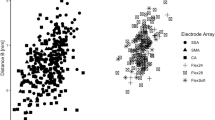Abstract
The overall complication rate of cochlear implant surgery is low and so-called electrode failures (electrode migration, misplacement, etc.,) account for only a minority of all complications. The aim of this study was to explore the prevalence of electrode migration as the cause for increased impedance values and non-auditory stimulation in the basal channels. Within the scope of a quality control process, the cochlear implant database of the Kuopio University Hospital (Finland) was reviewed. Patients with gradual elevation of impedance values and/or non-auditory stimulation of the basal electrode channels were re-examined and cone-beam computed tomography was administered. There were 162 cochlear implant recipients and 201 implanted devices registered in the database. A total of 18 patients (18 devices) were identified having significantly increased impedance values or non-auditory stimulation of the basal electrodes. Cone-beam computed tomography revealed extra-cochlear electrodes in 12 of these patients due to the migration of the electrode array. All extruded electrodes were lateral wall electrodes, i.e., straight electrode arrays (Cochlear CI422 and Med-El devices). The most common feature of electrode migration was the gradual increase of the impedance values in the basal electrodes, even though telemetry could also be unsuspicious. Electrode migration after cochlear implant surgery may be more common than previously reported. At surgery, special attention should be paid to the reliable fixation of the electrode array. This study underlines the importance of postoperative imaging after cochlear implant surgery.



Similar content being viewed by others
References
Wang JT, Wang AY, Psarros C, Da Cruz M (2014) Rates of revision and device failure in cochlear implant surgery: a 30-year experience. Laryngoscope 124(10):2393–2399
Masterson L, Kumar S, Kong JH et al (2012) Cochlear implant failures: lessons learned from a UK centre. J Laryngol Otol 126(1):15–21
Zeitler DM, Budenz CL, Roland JT Jr (2009) Revision cochlear implantation. Curr Opin Otolaryngol Head Neck Surg. 17(5):334–338
Chung D, Kim AH, Parisier S et al (2010) Revision cochlear implant surgery in patients with suspected soft failures. Otol Neurotol 31:1194–1198
Green KM, Bhatt YM, Saeed SR et al (2004) Complications following adult cochlear implantation. J Laryngol Otol 118:417–420
Brown KD, Connell SS, Balkany TJ, Eshraghi AE, Telischi FF, Angeli SA (2009) Incidence and indications for revision cochlear implant surgery in adults and children. Laryngoscope 119(1):152–157
Rivas A, Marlowe AL, Chinnici JE, Niparko JK, Francis HW (2008) Revison cochlear implantation surgery in adults: indications and results. Otol Neurotol 29:639–648
Ikeya J, Kawano A, Nishiyama N, Kawaguchi S et al (2013) Long-term complications after cochlear implantation. Auris Nasus Larynx 40(6):525–529
Connell SS, Balkany TJ, Hodges AV et al (2008) Electrode migration after cochlear implantation. Otol Neurotol 29:156–159
Cullen RD, Fayad JN, Luxford WM, Buchman CA (2008) Revision cochlear implant surgery in children. Otol Neurotol 29(2):214–220
Balkany T, Telischi FF (1995) Fixation of the electrode cable during cochlear implantation: the split bridge technique. Laryngoscope 105(2):217–218
Cohen NL, Kuzma J (1995) Titanium clip for cochlear implant electrode fixation. Ann Otol Rhinol Laryngol Suppl 166:402–403
Lenarz T, Stover T, Buechner A et al (2009) Hearing conservation surgery using the Hybrid-L electrode. Results from the first clinical trial at the Medical University of Hannover. Audiol Neurootol 14(Suppl 1):22–31
Lin JW, Mody A, Tonini R et al (2010) Characteristics of malfunctioning channels in pediatric cochlear implants. Laryngoscope 120(2):399–404
Zeitler DM, Lalwani AK, Roland JT et al (2009) The effects of cochlear implant electrode deactivation on speech perception and in predicting device failure. Otol Neurotol 30(1):7–13
Schow B, Friedland DR, Jensen J, Burg L, Runge CL (2012) Electrode failure and device failure in adult cochlear implantation. Cochlear Implants Int 13(1):35–40
Aschendorff A, Kubalek R, Turoski B et al (2005) Quality Control after Cochlear Implant Surgery by means of Rotational Tomography. Otol Neurotol 26(1):34–37
Aschendorff A (2011) Imaging in cochlear implant patients. Laryngorhino-otologie. 90(Suppl 1):S16–S21
Wanna GB, Noble JH, Carlson ML et al (2014) Impact of electrode design and surgical approach on scalar location and cochlear implant outcomes. Laryngoscope 124(suppl 6):S1–S7
Pearl MS, Roy A, Limb CJ (2014) High-resolution flat-panel computed tomography imaging of cochlear implants. Operative Techniques in Otolaryngology 25:321–326
Dietz A, Varonen S, Hyvärinen A, Löppönen H (2013) Paediatric cochlear implantation surgery: surgical aspects and preliminary results on hearing preservation, electrode placement and performance with the Cochlear Nucleus® CI422 Implant. Audiol Neurotol 18(suppl 1):17–19
Paasche G, Bockel F, Tasche C, Lesinski-Schiedat A, Lenarz T (2006) Changes of postoperative impedances in cochlear implant patients: short-term effect of modified electrode surfaces and intracochlear corticosteroids. Otol Neurotol 27:639–647
De Ceulaer G, Johnson S, Yperman M et al (2003) Long-term evaluation of the effect of intracochlear steroid deposition on electrode impedance in cochlear implant patients. Otol Neurotol 24:769–774
Seyyedi M (2014) Intracochlear inflammatory response to cochlear implant electrodes in humans. Otol Neurotol 35(9):1545–1551
Vlastarakos PV, Nikolopoulos TP, Maragoudakis P, Tzagaroulakis A, Ferekidis E (2007) Biofilms in ear, nose, and throat infections: how important are they? Laryngoscope 117(4):668–673
Author information
Authors and Affiliations
Corresponding author
Ethics declarations
Conflict of interest
The authors declare that they have no conflict of interest.
Rights and permissions
About this article
Cite this article
Dietz, A., Wennström, M., Lehtimäki, A. et al. Electrode migration after cochlear implant surgery: more common than expected?. Eur Arch Otorhinolaryngol 273, 1411–1418 (2016). https://doi.org/10.1007/s00405-015-3716-4
Received:
Accepted:
Published:
Issue Date:
DOI: https://doi.org/10.1007/s00405-015-3716-4




